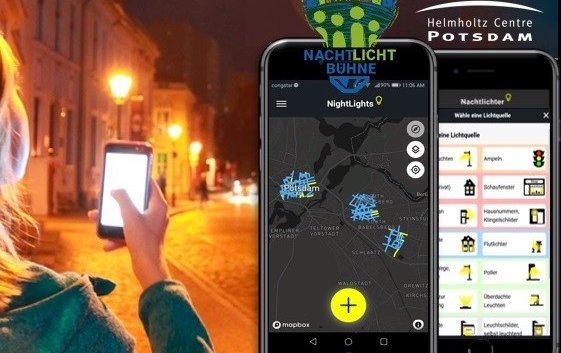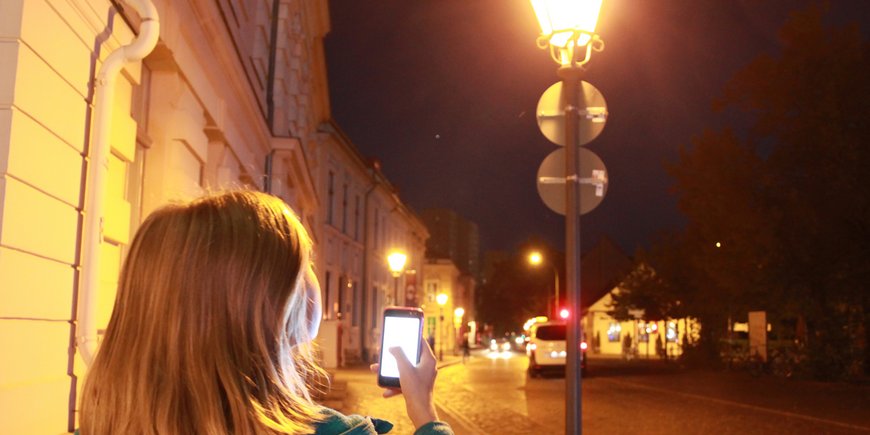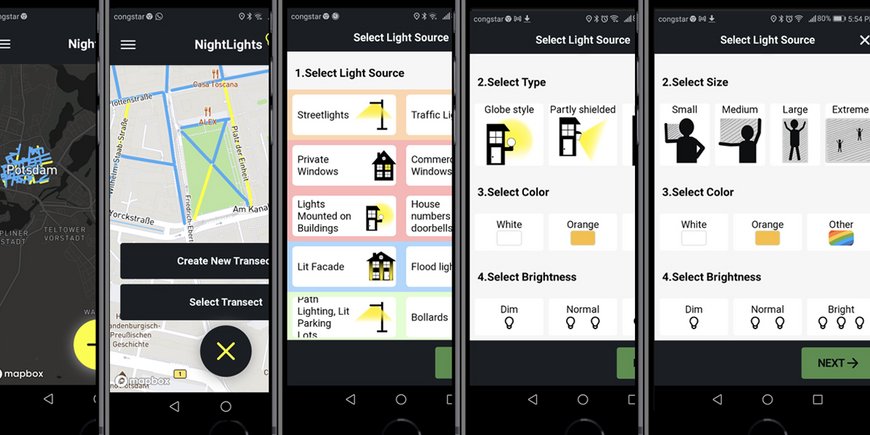"Night Lights" citizen science campaigns successfully completed: in a worldwide campaign, the participants counted and classified almost a quarter of a million artificial light sources in public streets and places
Summary
Excessive artificial lighting of public spaces consumes energy and disturbs the day-night rhythm of living creatures. To address this problem of "light pollution", awareness and knowledge of the sources is needed. A series of citizen science data collection campaigns has now been successfully completed, which have been taking place since the end of August under the title 'Night Lights' and under the leadership of the German Research Centre for Geosciences Potsdam GFZ. As part of the worldwide campaign, participants counted and classified almost a quarter of a million artificial light sources in public streets and squares. The data was collected using the Night Lights app, which the GFZ team had developed specifically for this purpose in a co-design process with a group of citizen scientists. The participants are also involved in the presentation of the project at conferences, in the evaluation of the data, which is now beginning, and in the scientific publications. The first results are expected from mid-2022.
Background of the project
In recent years, public awareness of 'light pollution' and the health and ecological effects of artificial light has grown: not only does it consume a lot of energy, but it also disturbs the day-night rhythm of fauna and flora. At the same time, satellite and aerial photographs of the earth at night show that lighting in public spaces is getting brighter and brighter. What they do not show is which light sources on the ground cause these light emissions that are visible up into orbit. Closing this data gap is the goal of the "Night Lights" project.
Closing the data gap through citizen research with the app
With the help of the specially developed app and citizen scientists, artificial light sources on public streets and squares could be systematically recorded and mapped on the ground over large areas for the first time - in various German, European and North American cities. The web-based app makes it possible to record the brightness, colour and angles of emission for a wide variety of light sources - from street lamps and shop window lighting to neon signs and garden lights. While information on public lighting is already available for some cities and municipalities, private light sources are generally not systematically recorded.
Accompanying social science research
In addition to analysing light sources, the project includes accompanying social science research being conducted at the GFZ by Nona Schulte-Römer. In collaboration with the citizen scientists, she is exploring how the project can promote awareness and alliances for sustainable lighting and how we as a society understand, design and use lighting technology, how we interpret scientific findings and take them into account - or not – when we illuminate the night. Interim summary "We are delighted that so many people - from schoolchildren to pensioners - have taken part. They all contribute to the fact that we now have a unique data set with which we can better understand what exactly the sources of light emissions are, and how we can reduce light pollution in the future," is the first interim summary from Christopher Kyba, project manager on the part of the GFZ. Social scientist Nona Schulte-Römer adds: "The project was possible thanks to the great interest in and commitment to citizen science in Germany. The majority of those involved are motivated by the desire to protect the natural night, and make artificial lighting more sustainable."
The project in numbers
- Nearly a quarter million light sources were classified during the period August 23 - November 14, 2021.
- Observations were submitted from 10 different countries in total, but the majority came from Germany. (Details can be found on the project website: nachtlicht-buehne.de/startseite/nightlights/)
- A total of 241 participants submitted data (the overall number of participants is even larger, as we asked people to work in teams).
- Participants covered a total distance of 645 km.
- In terms of continuous area, a total of over 22 square km was covered. (This is far more the 6 square km we planned for in the original research proposal, thanks to the interest of citizen scientists to take part).
- The largest number of lights counted by a single individual was 12,403 (2021-11-16).
- 66 participants were able to classify and submit more than 1000 lights in their app surveys.
- Participants ranged from twelve-year-old children to retired adults.
Further information about the project can be found here:
https://www.gfz-potsdam.de/en/media-and-communication/news/details/article/we-count-lights-because-the-night-counts/
https://nachtlicht-buehne.de/startseite/nightlights/
Funding: “Night Lights” (Nachtlichter) is part of the pilot project Nachtlicht BüHNE (Bürger-Helmholtz-Netzwerk für die Erforschung von nächtlichen Lichtphänomenen) funded by the Helmholtz Association of German Research Centres.
Scientific contact:
Dr. Christopher Kyba
Section 1.4 Remote Sensing and Geoinformatics
Telegrafenberg
14473 Potsdam
Phone: +49 331 288-28973
Email: christopher.kyba@gfz-potsdam.de
Dr. Nona Schulte-Römer
Section 1.4 Remote Sensing and Geoinformatics
Telegrafenberg
14473 Potsdam
Phone: +49 331 288-1135
Email: nona.schulte-roemer@gfz-potsdam.de
Media contact:
Dr. Uta Deffke
Public and Media Relations
Helmholtz Centre Potsdam
GFZ German Research Centre for Geosciences
Telegrafenberg
14473 Potsdam
Phone: +49 331 288-1049
Email: uta.deffke@gfz-potsdam.de











![[Translate to English:] Torsten Sachs in front of a climate station on a field](/fileadmin/_processed_/3/9/csm__TorstenSachs_bearbeitet_GS_4a1365ef84.jpeg)

![[Translate to English:] left image flood at the Ahrtal: image from above, several houses are flooded; left image:: Heidi Kreibich;](/fileadmin/_processed_/4/4/csm_Bild2_9af0130e9f.png)



![[Translate to English:] Start der Vega Rakete](/fileadmin/_processed_/6/4/csm_20231201-kachel_Vega-VV23-launch_ESA-CNES-Arianespace_706716b68c.jpeg)









![[Translate to English:] Poster exhibition at the Brandenburg Hydrogen Day at the GFZ, some participants in the foreground](/fileadmin/_processed_/6/5/csm_Erster_Brandenburgischer_Wasserstofftag_GFZ_402fcec95e.jpeg)
![[Translate to English:] Group picture of the participants](/fileadmin/_processed_/9/4/csm_20231108_CAWa-Workshop-Tashkent_Gruppenbild_99ea779d8a.jpeg)

![[Translate to English:] [Translate to English:] Hörsaal](/fileadmin/_processed_/e/6/csm_H%C3%B6rsal_e21ac645fb.jpeg)


![[Translate to English:] The Delegations in the Historic Library on the Telegrafenberg. In the back there are from left to right, the Dutch Ambassador for Germany, Ronald van Roeden, the Dutch Minister for Education, Culture and Science, Robbert Dijkgraaf and the scientific director of the GFZ, Susanne Buiter.](/fileadmin/_processed_/d/b/csm_Kachel-2_9eba4b4212.jpeg)

